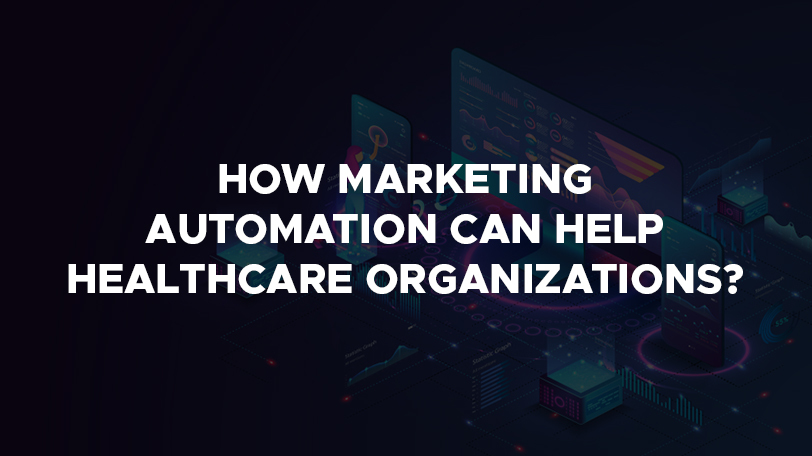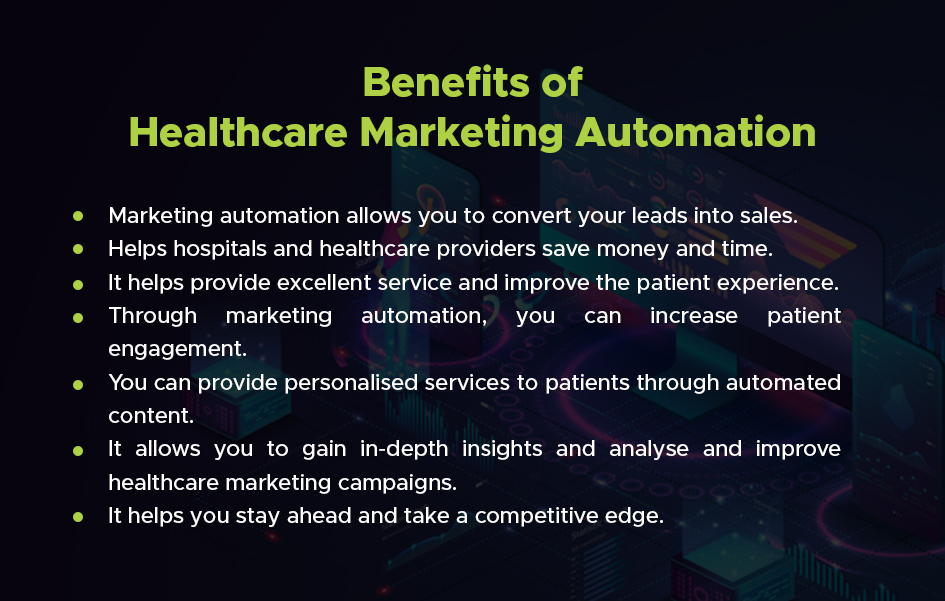- Enquiry For Sales: +91 7428094567
Enquiry For Jobs : +91 9116139991 - Request for quote
Blog

As a healthcare provider, do you use marketing automation best practices?
For example, when was the last time you sent content-rich information to your patients?
Do you keep a check on your patients’ health through various modes of communication or send follow-up messages?
If the answer is ‘No,’ you have to consider taking healthcare marketing automation seriously for your hospital or clinic.
Many large hospital chains and even specialised clinics know the power of healthcare marketing automation to transform their healthcare services. It offers tremendous benefits and has become essential to keep up with changing trends and the pandemic effect, as well as to meet patient demands. However, if you are hesitant to do so, you will lag, and the other healthcare providers who opt for automation will take a competitive advantage.
According to a report, the global digital health market was worth 175 billion U.S. dollars in 2019. It is estimated to grow 660 billion U.S. dollars by 2025. At the same time, the global marketing automation market size is forecasted to reach USD 8.42 billion by 2027. Also, according to a survey, 79% of large healthcare organisations said that automation would benefit revenue cycle management. Moreover, 60% said the supply chain would benefit from automation.
Marketing automation in healthcare uses technology-enabled marketing campaigns or strategies to allow healthcare providers to personalise their services according to their patients’ needs. With the help of healthcare marketing automation, doctors or healthcare organisations can provide personalised experiences to their existing and potential patients, depending on their behaviours.
Here are a few things you can automate to derive maximum benefits from healthcare automation.
Healthcare marketing automation can help large hospital chains automate their repetitive tasks, streamline marketing activity, and improve patient engagement. It allows hospitals to reduce human errors, personalise patient communications relevant to the receiver, and engage and serve patients to drive revenue. Hospitals can improve productivity, function hassle-free, and generate higher ROI by implementing healthcare automation.
Patient scheduling is an ongoing task at hospitals. It also plays a vital role in the success of a hospital and maximises revenue. Scheduling patients effectively and efficiently is critical to keeping missed appointments low. Achieving patient satisfaction through proper scheduling can be done by automating patient appointments.
For example, you can automate sending reminder emails, texts, voice messages, etc. It also helps you automatically convert inquiries into appointments.
Social media automation helps accomplish various tasks on social media platforms without human intervention. For example, you can automatically share information, reminders, health surveys, etc., with your patients. Automating content posting and sharing keeps the engagement level of your patients high.
Social media automation lets you capture the patient’s attention at the right time. At the same time, it helps you analyse audience behaviour, keep an eye on competitors, and much more to strategise accordingly.
Patient feedback is an excellent way to know patients’ feelings about your services and needs. It helps you collect real-time patient insights and improve your services. It also allows you to safeguard yourself from negative reviews on the internet. Patient feedback automation ensures more satisfied patients and excellent patient experience, builds your reputation, gains new patients, and drives desired results.
You can always stay on top of the minds of your patients with on-time and relevant emails and messages. Automating your communications with your patients provides a personalised experience. You can also analyse and track your email performance through metrics. Text messages are also revolutionising healthcare services by improving the ways patients and hospital professionals communicate. You can automate reminders, promote awareness, and more through text messages.
You can make the best use of re-engagement campaigns for no-show patients and lower the drop-off rate. This technique is to reach out to those patients who engaged and showed interest but did not show up. By automating re-engaging campaigns for healthcare, patients can be informed about their health conditions and be encouraged to make timely appointments and treatments.

You can maximise the benefits of healthcare marketing automation with Reinvent Digital, the best healthcare digital marketing company. With the help of our automation strategies, you can increase your patient engagement, develop lasting relationships with patients, increase revenue, and achieve phenomenal growth.
The experts at Reinvent Digital understand your processes and patients, curate a strategy, deploy automation tools, and get the desired results. To know the best healthcare automation strategy for your hospital, call us today.
What is marketing automation for healthcare?
Marketing automation for healthcare uses technology to personalise marketing campaigns and services according to patients’ needs. It allows healthcare providers to engage with patients in a personalised way based on their behaviours and preferences.
What tasks can be automated in healthcare marketing?
Some key tasks that can be automated include patient appointments/reminders, social media posting, collecting patient feedback, email/text messaging campaigns, and re-engagement campaigns for missed appointments.
How can automating appointments help hospitals?
Automating appointment scheduling and reminders can reduce missed appointments, maximise revenue, and improve patient satisfaction through efficient scheduling processes.
What are the benefits of healthcare marketing automation?
Key benefits include:
How can hospitals implement marketing automation effectively?
Hospitals can work with healthcare digital marketing experts who understand their processes and patients. The experts can develop an automation strategy, deploy the right tools, and execute campaigns to drive the desired results, like higher engagement and revenues.